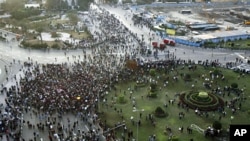As protesters mass night-after-night, Egypt's iconic main square is again a focus for national change. On Monday night, the Egyptian army put up some barricades among the throngs of demonstrators in Tahrir Square in the heart of modern Cairo.
The square is a large public space where major Egyptian political and cultural institutions are located and mass protests have been held over the years.
The square was named Tahrir, or Liberation, after Egypt's 1952 revolution, in which Egyptian military officers overthrew a constitutional monarchy and proclaimed a republic.
Prominent buildings surrounding the square include the Egyptian Antiquities Museum, the Arab League headquarters, an Egyptian government complex known as Mugamma, and several hotels.
Slideshow of the latest images from Egypt
Tahrir Square, located along the Nile River, is a magnet for tourists and Cairo's youth. It also is a major transportation hub for buses, taxis and Cairo's underground Metro railway.
It has seen several major demonstrations in recent years, including 2003 protests against the U.S.-led invasion of Iraq.
And it was a focal point during protests in 1977 when the government of then-President Anwar Sadat set off a fury by raising the price of bread.





